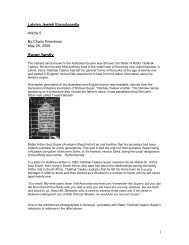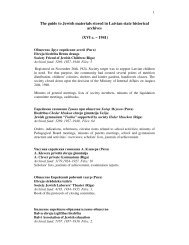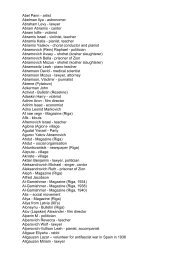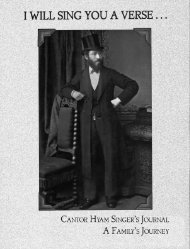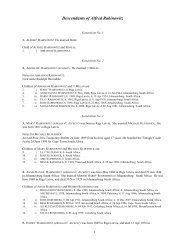Small Riga Ghetto
Small Riga Ghetto
Small Riga Ghetto
You also want an ePaper? Increase the reach of your titles
YUMPU automatically turns print PDFs into web optimized ePapers that Google loves.
147<br />
Professor Simon Dubnow<br />
and His Final Journey<br />
I have set myself a difficult task: writing a chapter dedicated to our great historian<br />
of this century, Professor Simon Dubnow.<br />
Although this is not easy for me, I have to do it nonetheless, because apart<br />
from the fact that his last journey is bound up with the churbn of Latvia, I am<br />
one of the few survivors to have had the great honor of seeing him — if not in<br />
his final hours, then at least in the final days before he died.<br />
Professor Simon Dubnow was born on 23 September 1860 in the city of<br />
Mstislawl (Mogilew under the Russian government). As a young man he left<br />
the tschertha-osiedlosci (the Jewish pale, or area reserved for Jews) and moved<br />
to Petersburg. There, in the former capital of Russia, he started as a young<br />
man to work for the Jewish journal "Woschod" (Sunrise). Later he moved to<br />
Odessa. There he decided to dedicate his life to Jewish history. For this reason<br />
he was attracted to Vilno, great Jewish Vilno, the Jerusalem of Lithuania. In<br />
this city he found the right place for himself and the right surroundings for his<br />
work (Dr. Zemach Schabad, Dr. Wigodski and others). From that point on,<br />
life in Vilno was closely bound up with Dubnow's scholarly studies. Wherever<br />
he could, he promoted his newly adopted home city and tried to attract the<br />
greatest Jewish public figures to it.<br />
Later on, before World War I (1914), he went to Russia and remained there<br />
until the outbreak of the great Bolshevik October Revolution. Then he moved<br />
for a short time to Kovno in Lithuania. He finally found a permanent place to<br />
do his work in Berlin. There he wrote his well-known ten-volume history of<br />
the Jewish people and his history of Hasidism.<br />
Professor Dubnow explained the riddle of how Judaism had survived for<br />
thousands of years by means of his theory of its wandering centers (Palestine,<br />
Babylon, Persia, Spain, Poland, Russia, America, and once again Palestine).<br />
Furthermore, he argued that the influence of religion on Judaism had weakened<br />
greatly in recent times, and he ascribed this fact to the secularization of<br />
Jewish culture. Accordingly, Professor Dubnow was criticized for having underestimated<br />
the significance of the Jewish religion as a factor in the preservation<br />
of Judaism.<br />
When National Socialism in Germany forced Dubnow to look for a new<br />
place to settle, he chose <strong>Riga</strong>, the capital of the small Republic of Latvia.<br />
In the beautiful <strong>Riga</strong> suburb of Mežaparks (Kaiserwald) he created a new<br />
Jewish intellectual center, and the Professor's white villa, nestling deep in the




